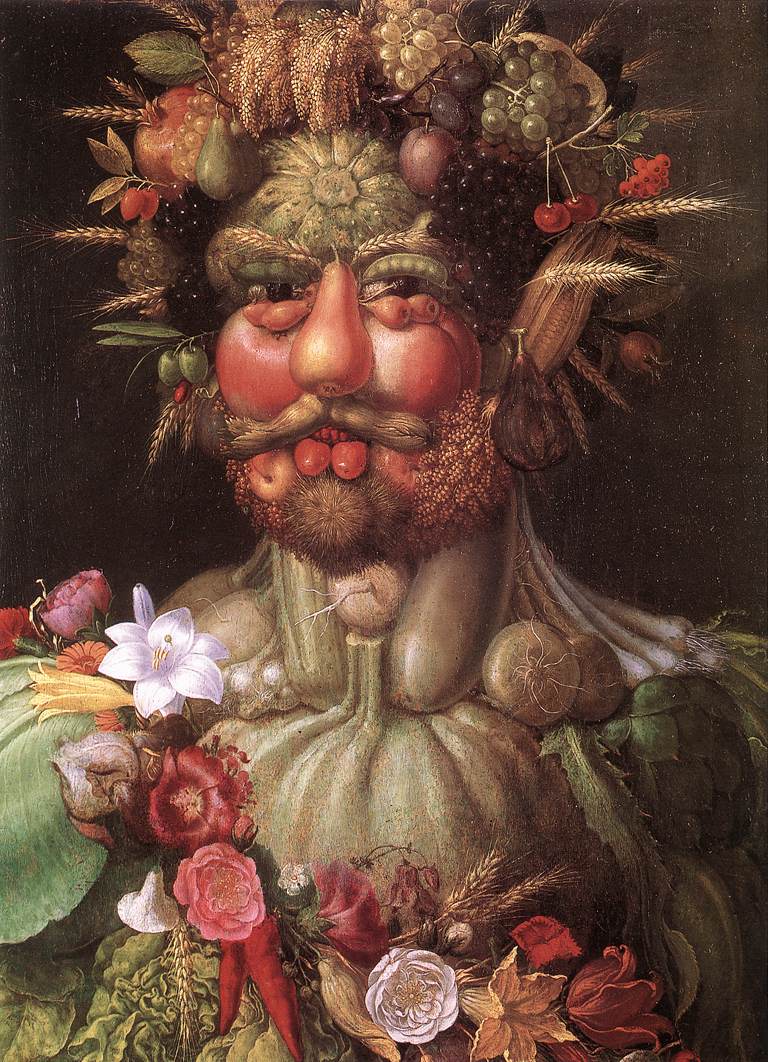- Giuseppe Arcimboldo
Infobox Artist
bgcolour = #EEDD82
name =Giuseppe Arcimboldo

imagesize = 150px
caption = Self-portrait
birthname =Giuseppe Arcimboldo
birthdate = 1527
location =Milan
deathdate = death date|1593|7|11|mf=y(age 66)
deathplace =Milan
nationality = Italian
field =Painting
training =
movement =
works = "The Librarian", 1566
"Vertumnus", 1590-1591
"Flora", c. 1591
patrons =
awards =Giuseppe Arcimboldo (also spelled "Arcimboldi";
1527 -July 11 1593 ) was an Italian painter best known for creating imaginative portraithead s made entirely of suchobject s asfruits ,vegetables ,flowers ,fish , andbooks -- that is, hepaint ed representations of these objects on thecanvas arranged in such a way that the whole collection of objects formed a recognisable likeness of theportrait subject .Biography
thumb|150px|left|Vertumnus ", a portrait of Rudolf II. Now atSkokloster Castle ,Sweden .]Arcimboldo was
born inMilan in 1527, theson of Biagio, a painter who did work for the office of the Fabbrica in the Duomo. [ [http://www.iht.com/articles/2007/10/05/arts/melik6.php Giuseppe Arcimboldo's hallucinations: Fantasy or insanity? - International Herald Tribune ] ] Arcimboldo was commissioned to dostained glass window designs beginning in 1549, including the "Stories of St. Catherine of Alexandria" vitrage at the Duomo. In 1556 he worked withGiuseppe Meda on frescoes for theCathedral of Monza . In 1558, he drew thecartoon for a largetapestry of theDormition of theVirgin Mary , which still hangs in the ComoCathedral today. [ [http://www.iht.com/articles/2007/10/05/arts/melik6.php Giuseppe Arcimboldo's hallucinations: Fantasy or insanity? - International Herald Tribune ] ]In 1562 he became court portraitist to Ferdinand I at the
Habsburg court inVienna , and later, to Maximilian II and his son Rudolf II at the court inPrague . He was also the court decorator and costume designer.King Augustus ofSaxony , who visitedVienna in 1570 and 1573, saw Arcimboldo's work and commissioned a copy of his "The Four Seasons" which incorporates his own monarchicsymbol s.Arcimboldo's conventional work, on traditional religious subjects, has fallen into oblivion, but his portraits of human heads made up of
vegetables ,fruit andtree roots , were greatly admired by his contemporaries and remain a source of fascination today.Art critics debate whether these paintings were whimsical or the product of a derangedmind . [ [http://www.iht.com/articles/2007/10/05/arts/melik6.php Giuseppe Arcimboldo's hallucinations: Fantasy or insanity? - International Herald Tribune ] ] . A majority of scholars hold to the view, however, that given the Renaissance fascination with riddles, puzzles, and the bizarre (see, for example, the grotesque heads ofLeonardo da Vinci , a fellow Milanese), Arcimboldo, far from being mentally imbalanced, catered to the taste of his times. Arcimboldo died inMilan , to which he retired after leaving the Habsburg service. It was during this last phase of his career that he produced the composite portrait of Rudolph II (see above), as well as his self-portrait as the Four Seasons. His Italian contemporaries honored him with poetry and manuscripts celebrating his illustrious career. His hidden-face still-lives are a possible influence on his younger Lombard contemporaryCaravaggio , whose painting of fruit in theBrera museum in Milan ranks as one of the earliest independent still-lives. When the Swedish army invadedPrague in 1648, during theThirty Years' War , many of Arcimboldo's paintings were taken fromRudolf II 's collection.His works can be found in Vienna's
Kunsthistorisches Museum and the Habsburg Schloss Ambras inInnsbruck , theLouvre in Paris, as well as numerous museums in Sweden. In Italy, his work is inCremona ,Brescia , and theUffizi Gallery inFlorence . TheWadsworth Atheneum in Hartford,Connecticut , theDenver Art Museum inDenver, Colorado , the Menil Foundation inHouston ,Texas , and the Candie Museum inGuernsey also ownpainting s by Archimboldo.Legacy The bizarre works of Arcimboldo, especially his multiple
image s, were rediscovered in the early 20th century bySurrealist artists likeSalvador Dalí . The “The Arcimboldo Effect” exhibition at thePalazzo Grassi inVenice (1987) included numerous 'double meaning' paintings. Arcimboldo's influence can also be seen in the work ofShigeo Fukuda ,István Orosz ,Octavio Ocampo , and Sandro del Prete, as well as the films ofJan Švankmajer . His painting, "Water", was used as the cover of the album "Masque" by theprogressive rock band Kansas.References
Gallery
ee also
*
Hidden faces External links
* [http://www.abcgallery.com/A/arcimboldo/arcimboldo.html Giuseppe Arcimboldo at Olga's Gallery]
* [http://www.tigtail.org/TIG/S_View/TVM/X1/c.Mannerism/arcimboldo/arcimboldo.html Arcimboldo at TVM]
* [http://www.all-art.org/early_renaissance/arcimboldo01biography.html Arcimboldo in the "A World History of Art"]
* [http://www.wga.hu/html/a/arcimbol/index.html Web Gallery of Art]
* [http://www.museumsyndicate.com/artist.php?artist=59 Arcimboldo at MuseumSyndicate]
* [http://www.aiwaz.net/gallery/arcimboldo-giuseppe/gc190 Arcimboldo at Panopticon Virtual Art Gallery]
* [http://lsh.it-norr.com/default.asp?id=4620 Skokloster Castle, Sweden]
* [http://arcimboldo.interfree.it Arcimboldo, from Milan's cathedral to european courts]
Wikimedia Foundation. 2010.

